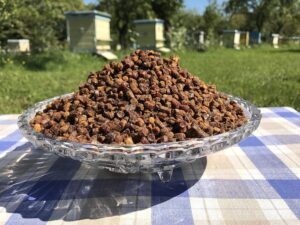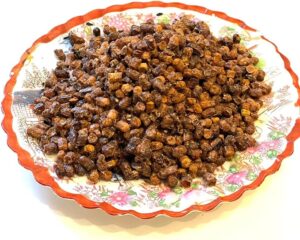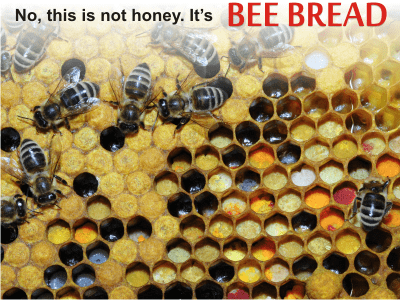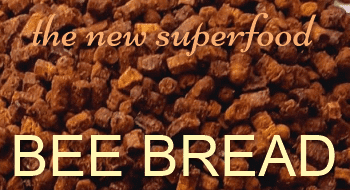There are more than 300 compounds in bee bread around the world, such as free amino acids, sugars, fatty acids, minerals, organic acids, polyphenols, and vitamins. It’s a superfood for bees and humans alike.
Bee bread, also written in one word, beebread, is a lesser-known product of the hive, equally nutritious and healthy.
Honey bees take their vital carbohydrates from nectar and pollen. The rest of their necessary nutrients, like lipids, proteins, minerals, and vitamins, cannot be found in nectar and will be taken almost exclusively from pollen. Using both of them, honey bees make bee bread.
On short, honey bees collect pollen, mix it with their saliva and honey, and then pack this mixture into the cells in the honeycomb. After 2 weeks, the bee bread is made. It needs a temperature of 35 to 36 °C, moisture and the activity of different enzymes from the bees’ saliva and some microorganisms including bacteria and yeasts.
Read more on how bee bread is made
Beekeepers should always let bee bread and honey for the honey bees during winter and early spring. Young bees and worker bees use bee bread to produce royal jelly to feed larvae with it.
We should also note that, recent in vivo studies have revealed the good health benefits of bee bread in relieving hyperglycemia, hyperlipidemia, inflammation, and oxidative stress. So, yes, it’s more than traditional claims.
What is bee bread made of?
Bee bread is never the same because it’s not a chemical drug prepared in a lab, following standard lines. It depends on the geographical and botanical origin of the pollen, climatic conditions, soil type, microbiota present in the cell, and also on the beekeeper’s devotion and storage treatments (for commercial purposes, of course). There will always be considerable variations in the centesimal composition of beedread.
However, there are some constituents that will always be present:
– water
It represents 30% of the fresh weight;
– carbohydrates
The average carbohydrate content of bee bread ranges from 24.40% to 34.80%, with fructose constituting the largest proportion of carbohydrates (57.51%), followed by glucose (42.59%) and maltose (3.37%).
Sucrose was used during the lactic acid fermentation of pollen into bee bread, that’s why the maximum amount found ca be of 0.12% to 0.16%.
Other sugars can be found in smaller quantities: trehalose, and maltose, but also fructofuranose α and β, α glucopyranose, mannitol, βD-glucopyranose, melezitose, and raffinose.
The carbohydrate content of this product is increased, compared to simple bee pollen, as a result of the addition of nectar and honey to the fresh pollen. The action of α- and β-amylase and αglucosidase results in the breakdown of polysaccharides into simple sugars.
Glucose and fructose are required by bacteria to ferment bee pollen into bee bread, which is digested into ethanol, lactic acid, and carbon dioxide by lactic acid bacteria. After mixing with the enzymes from the bees’ saliva, glucose and fructose can also turn into mannitol. All of these processes, and probably others, are responsible for the final sugar content. 
– proteins
Proteins represent between 17 and 30% of dry weight, according to the reviewed literature. According to Mohammad et al., protein use is higher in bee bread than in bee pollen. However, other scientists, such as Zuluaga and co-workers, say that the biochemical process induced by bees is aimed only at degrading the outer layer of the pollen grain, without causing any damage to the inner content; therefore, both bee bread and bee pollen have similar protein content.
Whatever the case, the amino acidic profile is higher in bee bread, due to degradation of pollen protein, which leads to more peptides and amino-acids. The microbial presence might be responsible for both the increase of amino acids through proteolysis and the decrease of amino acids, through its use as an energy source.
– lipids
The lipid content in bee bread may vary from 1.1 to 11.55% of dry weight. Scientific literature has described up to 37 fatty acids present in bee bread. Unsaturated fatty acids (UFAs) predominate over saturated fatty acids (SFAs), with up to 77.32% of total fatty acids with respect to 28.68%, respectively.
Among UFAs, there is a good correlation between monounsaturated fatty acids (MUFAs) and polyunsaturated fatty acids (PUFAs), with a maximum of 72.15% and a 64.70%, respectively. The
presence of some essential polyunsaturated fatty acids in bee bread is very important especially for human health. As for the honey bees, some fatty acids, like oleic and palmitic acids, are important for their nutrition.
Other acids, like myristic, linoleic, and linolenic acids are relevant because they can inhibit the growth of spore-forming bacteria.
– organic acids
Organic acids are also present in bee bread. There are gluconic, formic, acetic, propionic, and butyric acids and even probiotics, including lactic acid.
Essential amino acids present in bee bread: arginine, histidine, isoleucine, leucine, methionine, phenylalanine, threonine, tryptophan, valine.
Non-essential amino acids present in bee bread: alanine, aspartic acid, glutamic acid, glycine, proline, serine, tyrosine, asparagine, glutamine.
– ashes
It represents between 1.93 and 3.42% of dry weight.
– minerals
The most abundant mineral reported for bee bread is potassium, followed by phosphorus, calcium, and magnesium. (The studies used accurate technology to analyze minerals, i.e. inductively coupled plasma mass spectrometry.) Others are also present: zinc, iron, manganese, copper, sodium and selenium.
The presence of minerals in bee pollen is the soil and the pollen gathered from flowers. In bee bread the nectar of the flowers is also added, and this is a relevant source of minerals.
– vitamins
While we have plenty of data on the presence of vitamins in bee pollen, even found in rich numbers, the available literature on bee bread has scarce info on their presence in bee bread. There is no mention of its content in various fat- and water-soluble vitamins; after an exhaustive search for vitamin values, only levels of tocopherol and vitamin C have been documented.
– phenols
Because bee pollen is one of its main components, the presence of phenolic compounds is highly expected in bee bread.
total phenolic content (mg of GAE/g) ranges from 2.53 to 13.75;
total flavonoid content (mg of QE/g) from 1.94 to 4.51;
Rutin is the main component observed, and quercetin is also present in an important concentration.
Due to bacterial action, bee bread can have a different compound proportion. Thus, Bayran et al. have observed some compounds to be higher in bee pollen, such as caffeic acid, rutin, ethyl gallate, trans-ferulic acid, and myricetin, and in other cases higher in bee bread: catechin, protocatechuic acid, p-coumaric acid, quercetin, 2,5-dihydroxybenzoic acid, kaempferol, gallic acid, chlorogenic acid, salicylic acid, luteolin, gentisic acid, and isorhamnetin.
However, the importance of geographical and botanical provenience is the most important. These values can vary a lot. Lots of differences in quantity and regional variations in bee pollen and bee bread have been confirmed in the study Bee Bread as a Functional Product: Phenolic Compounds, Amino Acid, Sugar, and Organic Acid Profiles, conducted by Aksem Aksoy et al., and published in 2024.

463g / 1 pound Bees Bread (Perga, Bienenbrot, Ambrosia) 2022 fresh,
available on Amazon, picture source Amazon
The antioxidant power of bee bread
The presence of phenolic compounds and other ingredients is what gives bee bread its antioxidant capacity. It has been described that bee bread has a similar or higher antioxidant capacity than honey or propolis.
• TEAC (μmol of Trolox/g) from 46.13 to 76.38 (Trolox equivalent antioxidant capacity)
• FRAP (μmol of Trolox/g) from 35.03 to 70.17 (ferric-ion-reducing antioxidant power)
It has been described that bee bread extracts are more effective against Gram-positive bacteria compared to Gram-negative bacteria. (Pełka, K. et al.);
Antitumoral activity has also been assayed in vitro in some studies. (Markiewicz-Żukowska, R et all.)
Bee bread also has anti-inflammatory and immunomodulatory effects, antihypertensive activity, hypolipidemic effect, and hepatoprotective actions.
Honey enriched with propolis and bee bread. They mentioned that while the total phenolic content of lemon honey was approximately 36 mg GAE/100 g, the addition of bee bread and propolis to lemon honey resulted in a total phenolic content value of 150 mg GAE/100 g and a DPPH activity of 53 Trolox/100 g.
What are the health benefits of bee bread?
What is the difference between beebread, aka bee bread, and bee pollen?
References:
– Bee Products: An Emblematic Example of Underutilized Sources of Bioactive Compounds by Francesca Giampieri, Jose Luis Quiles, Danila Cianciosi, Tamara Yuliett Forbes-Hernández, Francisco Josè Orantes-Bermejo, José Miguel Alvarez-Suarez, and Maurizio Battino, Journal of Agricultural and Food Chemistry Article ASAP
DOI: 10.1021/acs.jafc.1c05822
– Pełka, K.; Otłowska, O.; Worobo, R. W.; Szweda, P. Bee Bread Exhibits Higher Antimicrobial Potential Compared to Bee Pollen. Antibiotics 2021, 10, 125;
– Markiewicz-Żukowska, R.; Naliwajko, S. K.; Bartosiuk, E.; Moskwa, J.; Isidorov, V.; Soroczynska, J.; Borawska, M. H. Chemical ́ Composition and Antioxidant Activity of Beebread, and Its Influence
on the Glioblastoma Cell Line (U87MG). J. Apic. Sci. 2013, 57, 147−157.
– Khalifa, S. A. M.; Elashal, M.; Kieliszek, M.; Ghazala, N. E.; Farag, M. A.; Saeed, A.; Xiao, J.; Zou, X.; Khatib, A.; Göransson, U.; El-Seedi, H. R. Recent Insights into Chemical and Pharmacological
Studies of Bee Bread. Trends Food Sci. Technol. 2020, 97, 300−316.
Featured picture credit: foam via flickr.com




